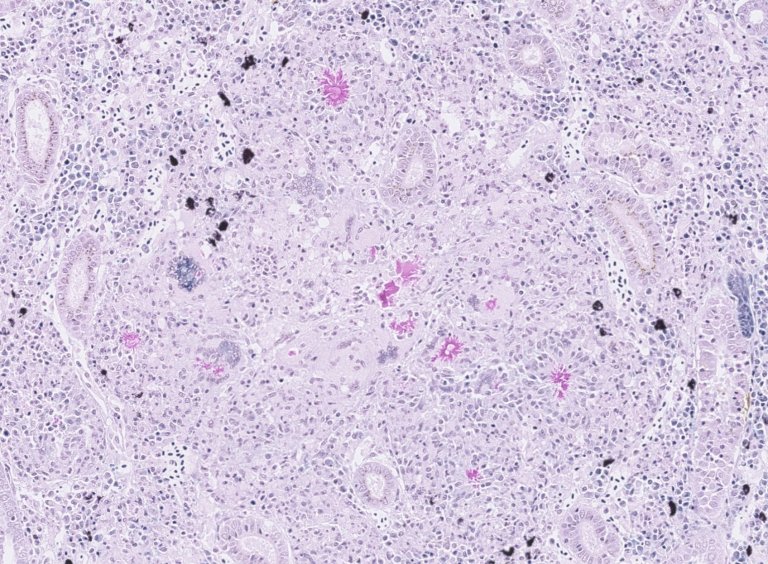_web.jpg)
Photo: Adam Zerihun
Mycobacteriosis is an infectious disease caused by Mycobacterium species. Several species have been described, some of which are associated with disease in fish. Among these, Mycobacterium salmoniphilum has been detected in salmonids in Norway.
Cod (Gadus morhua) has also been shown to be susceptible to this bacterium in experiments conducted by the Norwegian Veterinary Institute. In 2023, mycobacteriosis was confirmed in mackerel in Norway for the first time.
Mycobacteriosis is not a notifiable disease in salmonids, and currently, there is no effective vaccine or treatment available. General precautions are recommended to prevent contact between infected material and broken skin during handling of infected fish, as certain fish-pathogenic mycobacteria may pose a zoonotic risk.
Pathogen and Transmission
Mycobacteria are widespread in nature, with many species described—some of which are pathogenic to humans and animals. The best-known are members of the so-called Mycobacterium tuberculosis complex, which causes serious diseases in humans and animals. Atypical mycobacteria, also referred to as non-tuberculous mycobacteria (NTM) or mycobacteria other than tuberculosis (MOTT), are found in a variety of wild, farmed, and aquarium fish species in both freshwater and marine environments. Outbreaks caused by these mycobacteria can result in high mortality and significant economic losses.
The most well-known fish-pathogenic species include M. fortuitum, M. marinum, M. chelonae, M. shottsii, M. pseudoshottsii, and M. salmoniphilum. Molecular analysis has shown that M. salmoniphilum is closely related to M. chelonae.
Taxonomy within this bacterial group has been proposed for revision, although the new genus names remain debated. Both the original Mycobacterium designation and the proposed new genera are currently in use. For example, M. chelonae and M. salmoniphilum have been suggested for inclusion in the genus Mycobacteroides, M. fortuitum in Mycolicibacterium, while M. marinum remains classified under Mycobacterium.
Transmission is believed to occur mainly through direct contact with infected fish, feed, or water. Vertical transmission (from broodstock to offspring) has been described in some fish species but is not considered a major route of infection. The incubation period is long—potentially several weeks—and infected fish may remain asymptomatic for years. It is not yet fully understood whether fish-associated mycobacteria act as primary or secondary pathogens, but evidence suggests that the infection weakens the immune system and predispose fish to secondary infections by other agents.
Clinical Signs
Mycobacteriosis typically manifests as a chronic condition with varying mortality. Clinical signs are often vague and include lethargy and reduced growth. Some fish develop skin ulcers and hemorrhages. Emaciation is a common finding in fish with prolonged disease. In recent years, an acute form has also been described, where histopathological examination has revealed fibrinous peritonitis with bacterial presence along the peritoneum, necrosis in internal organs, and large numbers of rod-shaped bacteria in blood vessels and interstitial tissues in the heart, gills, liver, kidney, skin, and musculature.
Diagnosis
During necropsy of infected fish, pathological findings often include granulomas in internal organs, skin lesions, and swollen spleen and kidney. Granuloma formation may be less pronounced in salmonids than in other species.
Histological sections may show granulomas in internal organs, occasionally with Splendore–Hoeppli material centrally within granulomas. Mycobacteria are acid-fast rods and can be visualized in tissue sections using special stains such as Ziehl–Neelsen and/or immunohistochemistry with specific antibodies.
M. salmoniphilum grows at 22–30 °C and is best cultured on selective media such as Middlebrook 7H10 agar or CHAB agar. Some fast-growing mycobacterial species can also grow on blood agar. The bacterium can also be detected using molecular biology techniques.
Differential Diagnoses
Relevant differential diagnoses vary by fish species and include infections caused by Yersinia ruckeri, Francisella noatunensis, Piscirickettsia salmonis, Renibacterium salmoninarum, and Nocardia spp. In particular, Nocardia infections can be difficult to distinguish from mycobacterial infections.

Photo: Julie Christine Svendsen, Norwegian Veterinary Institute
Occurrence
Prior to 2006, mycobacteriosis was diagnosed only sporadically in Norway, mainly in aquarium fish and wild fish. In 2006–2007, the Norwegian Veterinary Institute diagnosed mycobacteriosis caused by M. salmoniphilum at approximately 11 salmonid farming sites. A few additional outbreaks were reported in 2008 and 2009. Following a quiet period, three new cases were reported in 2018–2019. Since then, the disease has been detected annually with varying prevalence, peaking in 2023.
Control Measures
Mycobacteriosis in fish is not a notifiable disease in Norway, and there are currently no clear regulatory guidelines for managing it in aquaculture facilities.
No effective treatment currently exists. The bacterium’s cell wall structure and the formation of granulomas make it difficult to treat with antimicrobials. There are no licensed vaccines for this disease in fish.
Most fish-pathogenic mycobacteria, including M. salmoniphilum, do not grow at 37 °C, and there is currently no solid evidence to suggest that human consumption of infected fish poses a health risk. However, several mycobacteria—including M. marinum and M. chelonae, which are closely related to M. salmoniphilum—can cause superficial skin granulomas and ulcers in humans and may spread to deeper tissues in immunocompromised individuals.
General precautions are therefore recommended to prevent contact between infected material and broken skin when handling infected fish.
%20(1).jpg)